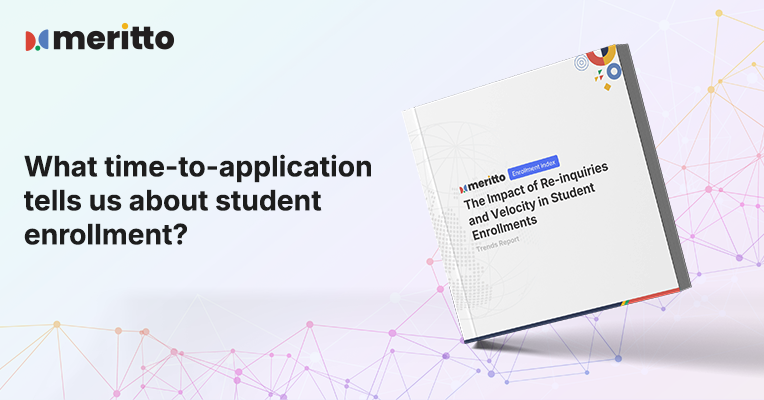In the fast-evolving world of student recruitment, first inquiries are no longer the full story, they’re just the beginning. For institutions looking beyond surface-level metrics, the real insight lies not just in who inquires, but when and how they choose to act.
After launching Enrollment Index 2025 earlier this year, we took a closer look at how student journeys are unfolding in real-time. Our latest Enrollment Index Trends Report, “The Impact of Re-inquiries, Engagement, and Velocity in Student Enrollments,” brings new light to a critical, often overlooked signal: time-to-application. At first glance, it may appear to be a simple operational metric. But a closer look reveals its potential as a window into student behavior, decision-making, and enrollment likelihood.
What is Time-to-Application?
Time-to-application refers to the number of days it takes for a prospective student to complete an application after their initial inquiry. While institutions often focus efforts on speeding up this process, our analysis suggests that the time taken to apply might not be a weakness; it might actually indicate deeper intent.
This isn’t to say early applicants aren’t valuable but it’s a prompt to pay more attention to the long-game. Those who take longer, revisit, and re-engage after initial silence are often more certain in their decision, and more likely to contribute meaningfully to actual enrollments.
What the data tells us
Let’s break this down based on what the numbers show:
- Primary inquiries (who apply within 0–5 days) represent the “early birds.” They’re often responsive and enthusiastic, but not always the most consistent contributors to final enrollment numbers.
- Secondary leads (applying within 6–30 days) demonstrate a more deliberate approach. They’ve likely engaged with more information, evaluated options, and reflected before submitting.
- Tertiary applicants and re-inquiries (30+ days) are where things get interesting. Despite taking longer, their eventual application often correlates with higher commitment and they’re more likely to convert.
💡Perhaps most surprising, students applying 90+ days after initial inquiry still make up 6.5% of total enrollments. That’s a meaningful slice of your final numbers often missed by short-term engagement strategies.
This behavior aligns closely with another trend: re-inquiries. These are prospective students who engage once, go quiet, and then return weeks or months later with renewed interest. What we see here is a student not lost, but thinking, researching, evaluating. Their eventual application is not impulsive, but often the product of a longer decision-making arc. When they come back, it’s not to start over, it’s to commit with clarity.
In this context, time-to-application becomes a signal of seriousness, not delay.
How it matters in understanding student intent
As recruitment strategies evolve, there’s growing recognition that today’s prospective students are not moving through a funnel, they’re navigating a maze. With more choices, more channels, and more uncertainties, their journeys are naturally non-linear. That means quick application doesn’t always equal strong interest and slow application doesn’t mean weak interest. In fact, the reverse is often true.
Understanding time-to-application as a behavioral indicator, rather than just an operational metric, helps institutions build more empathetic, responsive systems that meet students where they are in their process.
So, what’s the takeaway?
If you’re reflecting on these insights, here are a few subtle but important shifts to consider:
- Look beyond the first 30 days. Some of your most committed enrollments may come from prospective students who are still in a phase of active reflection.
- Don’t disregard re-inquiries. These aren’t just repeat actions, they’re renewed expressions of interest, often signaling stronger intent and higher conversion potential.
- Use timing as a window into behavior not just a performance metric. It’s not about accelerating every application. It’s about aligning with the natural rhythm of each student’s decision-making journey.
Final thoughts
In the quest to optimize recruitment, it’s easy to believe in faster-is-better. But the truth is, the pace at which a student applies tells a story not of efficiency, but of intention.
The insights in this report aren’t just observations, they’re a call to evolve. As we continue exploring the evolving dynamics of enrollment, this trend around time-to-application reminds us that student behavior is rarely linear and rarely predictable. But with the right data lens, it becomes understandable. And that understanding is where smarter recruitment truly begins.
This trend challenges the idea that the best prospects are always the fastest and in our Enrollment Index series, this is just one of many signals shaping the future of enrollment. Through it we are unpacking key behaviors from engagement rhythms to inquiry depth to help institutions move beyond surface-level metrics and into meaningful action.
Download your copy now and take a closer look at what’s driving enrollment success today. Schedule a personalized demo today
- CRM for Universities that Stops Student Drop-Offs before they Start
- CRM for Universities: Your Ultimate Guide to Smarter Admissions
- CRM for Universities: What the Best Ones Have in Common
- Why more universities are embracing CRM for Higher Education
- CRM for Higher Education: 7 Game-Changing Features You Didn’t Know You Needed




